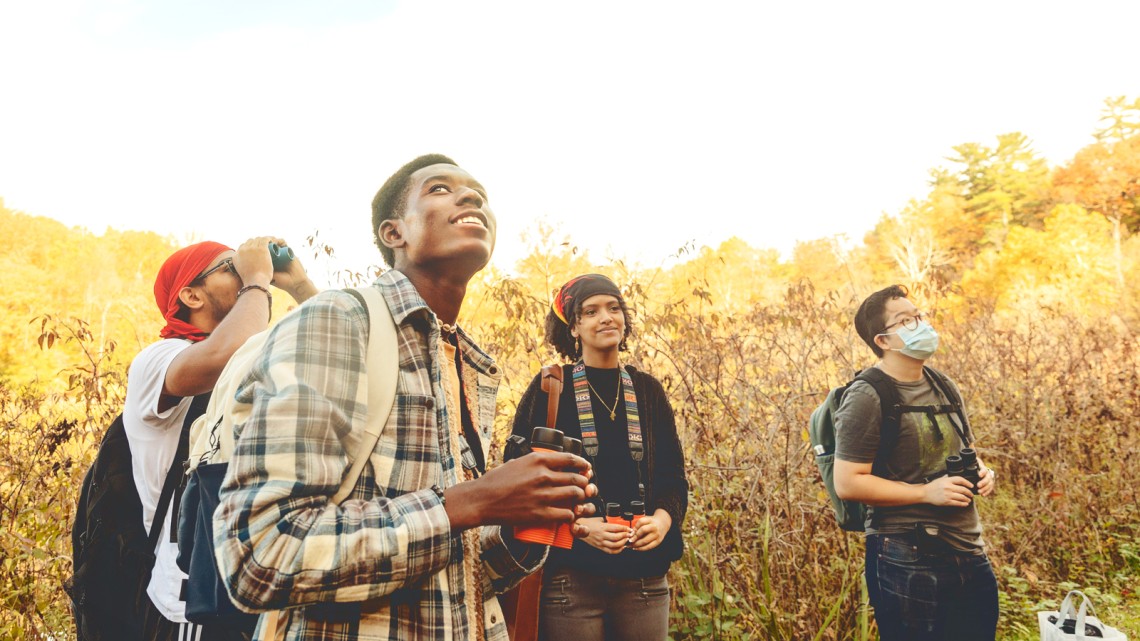
Isaiah Scott ’25 leads a birdwatching hike around Beebe Lake.
Flying high: Sophomore is a rising star in the birding world
By Beth Saulnier
Peering through binoculars, a half-dozen Cornellians admire a great blue heron standing on the opposite shore of Beebe Lake.
Their guide points a song sparrow on a branch, Canada geese and common mergansers idling on the water, an American goldfinch off in the distance, and a downy woodpecker moving up a tree trunk.
While the birds may be the main draw, the guide – a sophomore member of Cornell’s Birding Club – is drawing attention of his own.
A social media influencer with nearly 40,000 followers on Instagram, Isaiah Scott ’25 is emerging as a young adult leader in the national birding community. He’s passionate not only about conserving and appreciating avian species, but also attracting fellow Gen Zers and people of color to birding.
Majoring in ecology and evolutionary biology in the College of Agriculture and Life Sciences, Scott is a Georgia native who developed a passion for birding after visiting the Lab of Ornithology during a family visit to Ithaca for his older brother’s college tour. (Darius Scott ’22, a biological sciences major, will graduate from CALS in December.)
Isaiah Scott picked up his first pair of binoculars at the Lab’s gift shop, and went on to launch his own small-scale tour operation, Ike’s Birding Hikes, while in high school.
“I enjoy birdwatching so much, I want to share it,” he says. “I want people to be outdoors and experience the healing and regenerative power of nature – especially when seeing birds, because they’re such inspirational animals.”
After Ike’s Birding Hikes appeared on the local news in Georgia, the Ogeechee Audubon Society reached out to offer Scott a membership and to host some of his tours.
He has since gone on to become a leader of Cornell’s Birding Club, where he’s chair of diversity, equity, and inclusion, and study and work at the Hog Island Audubon Camp off the Maine coast. And he assisted on a grad student’s research project in Sapsucker Woods.
Third-year Ph.D. student Ethan Duvall tapped Scott to help collect data for his study of calcium consumption in birds, which is necessary for egg laying. The study involved positioning cameras in Sapsucker, setting out sources of calcium, such as bones and shells, then reviewing the footage to see what the birds favored.
“Isaiah is phenomenal in his passion and initiative toward trying to make the ornithological community a more inclusive space – but also a more fun space,” Duvall says. “He has a special ability to connect with people in a way that expresses how engaging birding can be.”
Scott was already leading his own birding hikes when a now-notorious case of bias made headlines in May 2020.
Christian Cooper, a Black man birding in a wooded area of New York City’s Central Park, was falsely accused of menacing by a white woman who had violated park rules by failing to leash her dog. The incident sparked discussion of “birding while Black,” shining a spotlight on the fact that minority birders can face hostility and threats due to racist assumptions that they don’t belong in certain neighborhoods or natural areas.
“Sadly, I wasn’t surprised, because I knew there were issues of how we’re stereotyped or racially profiled,” Scott says.
“I especially didn’t feel comfortable birdwatching alone; what if someone says something, or calls the police? But I’m really glad it opened up people’s eyes about these issues.”
Scott is also a skilled artist who creates watercolors of birds, which he sells through an online gallery. He’s a student brand ambassador for L.L. Bean and has modeled a trail sneaker for Zappos. And he’s working to raise $100,000 to purchase land for a nature preserve in Georgia.
In addition to serving as protected space for birds and other animals, the 40-acre facility would nurture the distinct cultural heritage of the Gullah Geechee people. The community, to which his family belongs, is descended from enslaved Africans who lived along the Southeastern seaboard.
Like many serious birders, Scott has a “life list” – the species he’s seen in person.
Of the roughly 300, he admits to a clear favorite: the painted bunting, which he first spied on an Audubon outing in Georgia.
“It’s a beautiful, small songbird,” he explains. “The males have a blue head with a red belly and green wings. It’s a very handsome bird, colorful and vibrant.”
Given Scott’s Instagram success and his interest in fashion, does he take certain inspiration from the avian world—where it’s usually the male of the species that displays the more colorful plumage?
“Yeah,” he says with a laugh. “The males have to look all nice and pretty for the females. Why don’t we take some notes? Let’s look good for the birds as well.”
Beth Saulnier is editor in chief of Cornellians, where the original version of this article first appeared.
Media Contact
Abby Kozlowski
Get Cornell news delivered right to your inbox.
Subscribe
